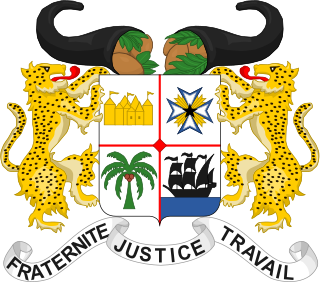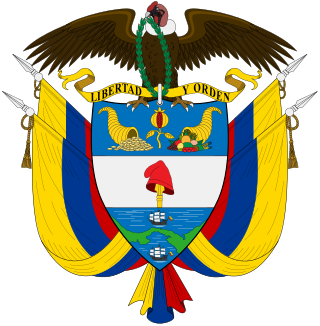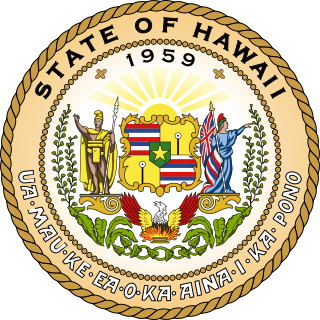
The coat of arms of South Africa is the main heraldic insignia of South Africa. The present coat of arms was introduced on Freedom Day, 27 April 2000, and was designed by Iaan Bekker. It replaced the earlier national arms, which had been in use since 1910. The motto is written in the extinct ǀXam, member of the Khoisan languages, and translates literally to "diverse people unite". The previous motto, in Latin, was Ex Unitate Vires, translated as "From unity, strength".

The coat of arms of the state of New York was formally adopted in 1778, and appears as a component of the state's flag and seal.

The coat of arms of the Philippines features the eight-rayed sun of the Philippines with each ray representing the eight provinces which were placed under martial law by Governor-General Ramón Blanco Sr. during the Philippine Revolution, and the three five-pointed stars representing the three major island groups of Luzon, the Visayas, and Mindanao.

The coat of arms of the state of New Jersey includes:

The coat of arms or national seal of Benin, originally introduced in 1964, was readopted in 1990 after being replaced in 1975.

The coat of arms of Colombia contains a shield with numerous symbols. Perched on top of the shield is an Andean condor holding an olive crown and the condor symbolizing freedom. The national motto, Libertad y Orden, is on a scroll in between the bird and the shield in black font over golden background. The condor is depicted as displayed and looking to the right.

The flag of Delaware consists of a buff-colored diamond on a field of colonial blue, with the coat of arms of the state of Delaware inside the diamond. Below the diamond, the date December 7, 1787, declares the day on which Delaware became the first state to ratify the United States Constitution. The colors of the flag reflect the colors of the uniform of General George Washington.

The Great Seal of the State of Hawaii was designated officially by Act 272 of the 1959 Territorial Legislature and is based on the territorial seal. Modifications to the territorial seal included the use of the words "State of Hawaii" at the top and "1959" within the circle. Provisions for a seal for the state of Hawaii were enacted by the Territorial Legislature and approved by Governor William F. Quinn on June 8, 1959. The passage of the Admission Act in 1959, admitted Hawaii as the 50th State of the United States of America on August 21, 1959.

The coat of arms of Malta is the national coat of arms of the country of Malta.

The great seal of the state of Delaware was first adopted on January 17, 1777, with the current version being adopted April 29, 2004. It contains the state coat of arms surrounded by an inscription.

The coat of arms or national emblem of Indonesia is called Garuda Pancasila in Indonesian. The main part is the Garuda with a heraldic shield on its chest and a scroll gripped by its legs. The shield's five emblems represent Pancasila, the five principles of Indonesia's national ideology. The Garuda claws gripping a white ribbon scroll inscribed with the national motto Bhinneka Tunggal Ika written in black text, which can be loosely translated as "Unity in Diversity". Garuda Pancasila was designed by Sultan Hamid II from Pontianak, supervised by Sukarno, and was adopted as the national emblem on 11 February 1950.

The Great Seal of the Commonwealth of Massachusetts contains the coat of arms of Massachusetts. The coat of arms is encircled by the Latin text "Sigillum Reipublicæ Massachusettensis". The Massachusetts Constitution designates the form of government a "commonwealth", for which respublica is the correct Latin term. The seal uses the coat of arms of Massachusetts as its central element.

The coat of arms of Nigeria consists of a black shield with a wavy white pall, symbolizing the meeting of the Niger and Benue Rivers at Lokoja. The black shield represents Nigeria's fertile soil, while the two supporting horses or chargers on each side represent dignity. The eagle represents strength, while the green and white twists of the torse on the top of the shield represent the rich soil.

The Emblem of Sudan was adopted in 1985.

The national emblem of East Timor is one of the national symbols of East Timor.

The coat of arms of Peru is the national symbolic emblem of Peru. Four variants are used: the coat of arms per se, the National Coat of Arms, the Great Seal of the State, and the Naval Coat of Arms.

The coat of arms of Haiti is the national coat of arms of the Republic of Haiti. It was originally introduced in 1807, and it has appeared in its current form since 1986. Since this Haitian national symbol does not conform to the rules of heraldry for a traditional coat of arms, then it could be considered a national emblem instead.

National symbols of France are emblems of the French Republic and French people, and they are the cornerstone of the nation's republican tradition.

The coat of arms of Pennsylvania is an official emblem of the Commonwealth of Pennsylvania, alongside the seal and state flag, and was adopted in 1778.
A national coat of arms is a symbol which denotes an independent state in the form of a heraldic achievement. While a national flag is usually used by the population at large and is flown outside and on ships, a national coat of arms is normally considered a symbol of the government or the head of state personally and tends to be used in print, on armorial ware, and as a wall decoration in official buildings. The royal arms of a monarchy, which may be identical to the national arms, are sometimes described as arms of dominion or arms of sovereignty.

























